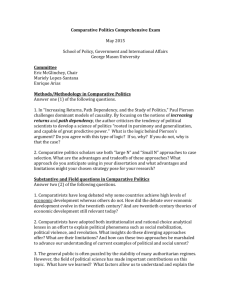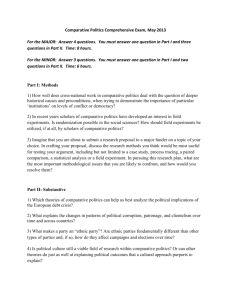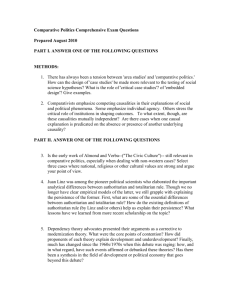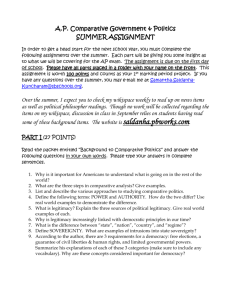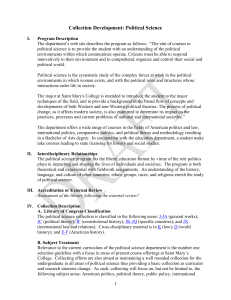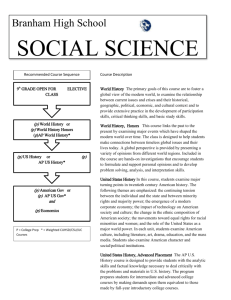Unit 1- Conceptual Introduction to Comparative Government and
advertisement
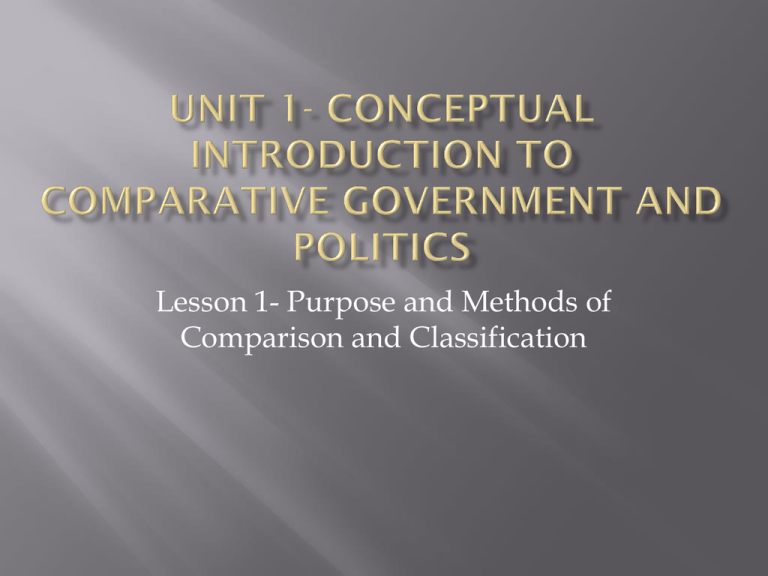
Lesson 1- Purpose and Methods of Comparison and Classification The AP Comparative Government & Politics course will compare the governments of six countries: United Kingdom, Russia, China, Nigeria, Mexico and Iran. By studying other political systems, students will not only have a better understanding of their own system but will also have an introduction to global politics. COUNTRY FACT SHEETS For each country, you will be expected to complete a country fact sheet (based off of the content in the various units. This sheet will be due on the test date for each country. Each student will be expected to use these country fact sheets to help compare and contrast between the various countries. Multiple Choice You will have 45 minutes to complete 55 MC questions. They are similar to the AP US Govt. & Politics exam in format.(50% of grade) Free Response Questions (50% of grade) Type I: Short Answer Questions They ask you to briefly define or describe a major concept in Comparative Politics and may or may not ask you to give an example from one of the countries. They can be answered in 2-3 sentences. There will be 5 of these on the exam. (suggested time: appx. 25 minutes to complete all 5) Free Response Questions Type II: Conceptual Questions This question will ask you to elaborate on one major concept in Comparative Politics and will NOT request country specific data. This may have several subparts that you must elaborate on. There is one of these types of questions and you should spend approx. 25 minutes on it. Free Response Questions Type III: Country Specific Questions These questions will ask you to provide country specific information to support a major concept in comparative politics. There are two of these types of questions and the suggested length of time for the two questions is 50 minutes You should take approx. 25 minutes each Almond: Comparative Politics Today The only way we can fully understand our own political system. Comparing the past and present of our nation and our experiences with other nations depends our understanding of our own political institutions. Comparing takes us beyond the familiar and helps us expand our awareness of the possibilities of politics. Helps us develop explanations and test theories of the way political change occurs. O’Neil- Essentials of Comparative Politics Helps us place our own system in perspective by highlighting alternatives to our own political order and challenging our common assumptions that there is one right way to organize political life. We ignore the outside world at our peril Examples of U.S ignoring outside world? By understanding politics in a comparative setting, we arm ourselves with the knowledge necessary to make informed political choices about our own lives. Quantitative Gathering of statistical data across a large number of countries in order to look for correlations and test hypotheses about cause and effect. “Breadth over depth” Researchers examine the relationships among variables and seek correlation and causal factors. More precise way of measuring things. Example: taxation rates, voter turnout, page 33 in Almond book. Qualitative Mastery of a limited number of cases through the detailed study of their history, language, and culture. Focuses on unique aspects of nations. “Depth over breadth” Researchers need the depth provided in these studied to form insightful hypothesis for statistical testing in the first place. Also, can examine cause and effect relationships. THINK/PAIR/SHARE: Which of these two methods is numerical? Verbal? Which method do you think you would best learn from or be better at researching? Why? The “Three World Approach” 1. 2. 3. First World countries-advanced capitalist democracies. Also known as Developed. Second world countries are the communist bloc (formerly run by the Soviet Union). Third world countries are the remaining states of the world who are not rich or western. Also known as Developing. North and South is another way to classify nations with the north being the richer, capitalistic democracies, generally. Big and Small States is the final way to classify nations. Geographic location has important strategic implications, often. Advanced Democracies These countries have well-established democratic governments and a high level of economic development. Ex. Great Britain Communist and Post-communist Countries These countries have sought to create a system that limits individual freedoms in order to divide wealth more equally. Current Trend: Democracy in the 21st Century Ex. Russia (post communist country) China (communist country) Less Developed Traditionally referred to as “third world” Currently experiencing rapid economic growth, tendency towards democratization, and political and social stability. Ex. Mexico and Iran (kind of) Newly Industrializing Countries Lack significant economic development. Authoritarian regimes. Ex. Nigeria (some democratization recently) 1. What are some institutions in the United States that we have not discussed and what is their significance? 2. Guidelines: List 5 political institutions and 5 physical institutions. Be ready to share with the class after your team’s discussion 3. What are some institutions in New York state, in New Paltz, and in your family? 1. 2. 3. Explain the importance of studying comparative politics. Describe some ways political scientists typically classify countries. Describe why institutions are important when studying comparative politics?

